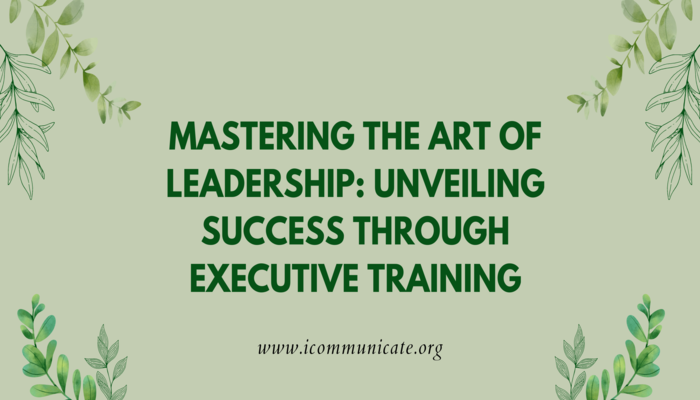Mastering the Art of Leadership: Unveiling Success through Executive Training
September 26, 2023 2023-09-26 18:21Mastering the Art of Leadership: Unveiling Success through Executive Training
Introduction
Leadership, like the artistry of the revered da Vinci or the strategic brilliance of Sun Tzu, requires a multi-dimensional approach. Beyond their immediate skills, these historical figures exemplified the essence of leadership – the constant pursuit of knowledge, adaptability, and the foresight for innovation. Drawing parallels, today’s leaders, equipped with executive training, are poised to usher in a renaissance in organizational growth and productivity.
Understanding the Essence of Leadership
Leadership isn’t just a role but an art. It’s not just about giving orders but inspiring greatness. Leaders like Abraham Lincoln and Winston Churchill were not just political heads but visionaries, strategists, and communicators. They could see the bigger picture, take risks, and, importantly, guide their nations during tumultuous times. In business, leadership is about creating a vision, establishing a direction, and navigating teams through change to achieve this vision. Like these historical icons, a true leader is a dreamer and an executor.
The Benefits of Executive Training
1. Refinement of Skills: As artists refine their techniques, executive training sharpens leaders’ decision-making and strategic planning abilities. Leaders learn to blend intuition with analytics, ensuring insightful and data-driven decisions.
2. Expansion of Perspectives: Just as the Renaissance was a period of broadened horizons and ideas, executive training provides exposure to various strategies, case studies, and global business scenarios, pushing leaders to think outside the box.
3. Increased Self-awareness: Like Socrates’ call to “know thyself,” training helps leaders introspect, understanding their strengths and growth areas, leading to a more balanced leadership approach.
4. Strategic Networking: Mingling with peers, much like the historic gatherings of thinkers and artists in Florence, can lead to collaborative ventures and the exchange of groundbreaking ideas.
5. Fostering Innovation: Incorporating the latest in technology and methodology, leaders can lead their organizations to new heights, reminiscent of how innovators of the past pioneered entire movements.
Critical Components of Effective Leadership Training
– Personalized Curriculum: Catering to individual and organizational needs ensures relevance. Like the apprenticeships of old, where artists learned under masters, a tailored curriculum provides targeted mentorship.
– Hands-on Application: Theory deepens understanding when blended with real-world applications. Leaders, through simulations, can walk the corridors of history, making decisions like world leaders during global crises and learning from them.
– Mentorship Opportunities: Training under experienced leaders is like young painters learning under stalwarts. With their vast experiences, these mentors provide insights that books and case studies might miss.
– Feedback Mechanisms: Constructive feedback, like critiques in an artist’s studio, refine skills and broaden perspectives.
– Continual Learning Modules: Leadership, like art, evolves. Leaders must remain students, consistently updating themselves with the changing business landscapes.
The Impact of Leadership on Organizational Success
Reflecting on history, leaders have always been the pivot for significant successes or failures. The leader’s vision, strategy, and adaptability have marked the difference between empires and corporations. Under astute leadership, an organization can weather economic downturns, adapt to market changes, and chart new territories. A well-trained executive can inspire the workforce, similar to how leaders like King, Gandhi, or Mandela inspired movements.
Choosing the Right Executive Training Program
1. Reputation and Credibility: The historical learning centers, like Alexandria’s Great Library, were renowned for a reason. Similarly, the institution’s reputation can determine its training quality.
2. Customizability: Each leader’s journey is unique. Training should be flexible enough to cater to these individual journeys, much like how different artists have varied styles and mediums.
3. Interactive Learning: Engaging in active discussions, brainstorming sessions, and strategic war-gaming can lead to better retention and understanding of complex topics.
4. Post-training Support: Continuous support, through resources or networking opportunities, ensures that the learning doesn’t stagnate. This can be likened to an artist’s continuous engagement with their guild or community.
5. Practical Relevance: Relevance is critical. Lessons should mirror modern challenges, ensuring leaders deal with contemporary business landscapes.
Conclusion
Mastering leadership is an ongoing journey. Like the timeless masterpieces that adorn museum walls or the strategic tomes that guide modern warfare, effective leadership stands the test of time. Equipped with executive training, today’s leaders stand on the shoulders of giants, drawing from the wellspring of historic wisdom while innovating for the future. Organizations find their path to success in this confluence of the past and the future.


